The Function and Potential of Innovative Reinforced Concrete Prefabrication Technologies in Achieving Residential Construction Goals in Germany and Poland
Abstract
:1. Introduction
2. Materials and Methods
3. Results
3.1. Prefabricated Housing
3.2. Contemporary Prefabricated Housing Systems and Projects
3.3. BIM Technology in Prefabricated Housing
3.4. Significance of Prefabricated Housing in Sustainable Development
4. Discussion
5. Practical Implications
6. Conclusions
7. Future Research
- Applying the potential of structural layouts that differ from commonly used wall- and wall-and-deck-based systems;
- Introducing prefabricated decks with greater spans that can enhance the organisation and adaptability of indoor spaces;
- Increasing the share of pre-made furnishings and fittings already attached to prefabricated segments and interior furnishings based on dry construction;
- Implementing modern technologies during prefabrication, using components, such as wood, glue-laminated wood and glass, which are 100% recyclable;
- Improving joints in layered walls so as to improve stability and protect the façade layer;
- Applying modern joints for internal prefabricated structural elements that can withstand high loads and reduce the occurrence of thermal bridges;
- Limiting the number of prefabricated element joints, reducing their visibility or completely eliminating them;
- Using varied materials, textures, patterns and colours that improve the aesthetics of façade layers;
- Limiting standardisation and simple repetitiveness in commercial designs in favour of bespoke prefabricated elements that are task-optimised;
- Pursuing innovative insulation materials for prefabricated external walls;
- Unconditionally ensuring environmentally friendly building disassembly by improving joint systems;
- Using prefabricated hollow core decks to trace HVAC ducts.
Author Contributions
Funding
Data Availability Statement
Conflicts of Interest
References
- New European Bauhaus. European Union. Available online: https://europa.eu/new-european-bauhaus/index_en (accessed on 25 June 2021).
- European Commission. Construction and Demolition Waste. 2008. Available online: https://ec.europa.eu/environment/topics/waste-and-recycling/construction-and-demolition-waste_en (accessed on 25 June 2021).
- IPCC; Poloczanska, E.; Mintenbeck, K.; Portner, H.O.; Roberts, D.; Levin, L.A. IPCC Special Report on the Ocean and Cryosphere in a Changing Climate; IPCC: Geneva, Switzerland, 2019; Available online: https://report.ipcc.ch/srocc/pdf/SROCC_FinalDraft_FullReport.pdf (accessed on 15 July 2021).
- Statistics Poland. Główny Urząd Statystyczny (Eng. Statistics Poland). Available online: https://stat.gov.pl/ (accessed on 25 June 2021).
- Statistisches Bundesamt (Destatis). Available online: https://www.destatis.de/ (accessed on 25 June 2021).
- Budizol Sp. z o.o. S.K.A. Available online: https://budizol.com.pl/eng/p/concrete-prefabrication (accessed on 25 June 2021).
- Pekabex SA. Available online: https://pekabex.pl/en/ (accessed on 25 June 2021).
- Firmengruppe Max Bögl. Available online: https://max-boegl.de/ (accessed on 25 June 2021).
- GOLDBECK Gmbh. Available online: https://www.goldbeck.de/ (accessed on 25 June 2021).
- Sustainability Matters 2020. Available online: https://www.britishprecast.org/getattachment/Sustainability/Sustainability-Report/Sustainability-Matters-2020-(FINAL).pdf.aspx?lang=en-GB (accessed on 15 July 2021).
- Rai, B.; Wille, K. Development and testing of High/Ultra-High Early Strength Concrete. In Proceedings of the HiPerMat 2020, 5th International Symposium on Ultra-High. Performance Concrete and High. Performance Construction Materials, Kassel, Germany, 11–13 March 2020; pp. 7–8. [Google Scholar]
- Janczura, K. Prefabrykaty z betonów o wysokiej i ultrawysokiej wytrzymałości—Teraz czy dopiero jutro? Bud. Technol. Archit. 2017, 3, 58–62. [Google Scholar]
- Bigaj, P. Monolityczne Technologie Betonu Architektonicznego w Architekturze Współczesnych Budynków Mieszkalnych. Ph.D. Thesis, Faculty of Architecture, Cracow University of Technology, Kraków, Poland, 2013; pp. 97–105. [Google Scholar]
- Jarek, B.; Kubik, A. Politechnika Krakowska, Zastosowanie prętów zbrojeniowych z włókna szklanego (GRFP) w budownictwie. Przegląd Bud. 2015, 86, 21–26. [Google Scholar]
- Derkowski, W.; Cholewicki, A.; Niesyczyński, M.; Skupień, P. Prefabrykacja—Jakość, Trwałość, Różnorodność. Obiekty Kubaturowe Mieszkalne i inne, w Których Głównym Układem Konstrukcyjnym są Ściany; Book 3; Stowarzyszenie Producentów Betonów: Warszawa, Poland, 2017. [Google Scholar]
- Bachmann, H.; Steinle, A. Precast Concrete Structures; Ernst & Sohn GmbH: Berlin, Germany, 2011. [Google Scholar]
- FIB. Prefabrication for Affordable Housing; State-of-the-Art Report, Federation Internationale de Béton Bulletin 60; FIB: Lausanne, Switzerland, 2011. [Google Scholar]
- FIB. Structural Connections for Precast Concrete Buildings; State-of-the-Art Report, Federation Internationale de Béton Bulletin 43; FIB: Laussane, Switzerland, 2008. [Google Scholar]
- Smith, R.E. Prefab Architecture: A Guide to Modular Design and Construction; John Wiley & Sons: Hoboken, NJ, USA, 2010. [Google Scholar]
- PFEIFER-VS® System Przestrzenny 3D, Revision: May 2015. Available online: https://jordahl-pfeifer.pl/wp-content/uploads/2021/03/PFEIFER_VS_PL.pdf (accessed on 24 June 2021).
- Demiche, Y.; Vorona-Slivinskaya, L.; Voskresenskaya, E. Method of dry construction of prefabricated reinforced concrete building. In Proceedings of the IOP Conference Series: Materials Science and Engineering, VIII International Scientific Conference Transport of Siberia, Novosibirsk, Russia, 22–27 May 2020; Volume 918. [Google Scholar]
- Tamayo-García, B.; Albareda-Valls, A.; Rivera-Rogel, A.; Cornado, C. Mechanical Characterization of a New Architectural Concrete with Glass-Recycled Aggregate. Buildings 2019, 9, 145. [Google Scholar] [CrossRef] [Green Version]
- García-Alvarado, R.; Moroni-Orellana, G.; Banda-Pérez, P. Architectural Evaluation of 3D-Printed Buildings. Buildings 2021, 11, 254. [Google Scholar] [CrossRef]
- Adamczewski, G.; Chyła, T. Rola BIM w prefabrykacji oraz podczas procesu inwestycyjnego. Mater. Bud. 2018, 547, 75–77. [Google Scholar]
- Behaneck, M. BIM in precast concrete construction: First digital, then physical production and installation. BFT Int. 2017, 11, 52–62. [Google Scholar]
- Protchenko, K. Technologia BIM w prefabrykacji. Mater. Bud. 2020, 578, 22–23. [Google Scholar]
- Walczak, Z.; Szymczak-Graczyk, A.; Walczak, N. BIM jako narzędzie przyszłości w projektowaniu i rewitalizacji obiektów budowlanych. Przegląd Bud. 2017, 88, 20–26. [Google Scholar]
- System Pekabex Residential Buildings Brochure (EN), Revision: April 2020. Available online: https://pekabex.pl/en/download#catalogues (accessed on 25 June 2021).
- Elementy Izolacyjne Według Normy PN-EN 1992–1-1 Dla Balkonów Oraz Innych Termicznie Oddzielonych Elementów Zewnętrznych. Available online: https://jordahl-pfeifer.pl/wp-content/uploads/2021/04/ISOPRO.pdf (accessed on 25 June 2021).
- TSS/RVK. Efektywne i Ekonomiczne Połączenia w Klatkach Schodowych. Available online: https://jordahl-pfeifer.pl/wp-content/uploads/2021/03/TSS-RVK.pdf (accessed on 25 June 2021).
- Approved PFEIFER-VS® rail systems3D, Revision: March 2019. Available online: https://www.pfeifer.info/out/assets/PFEIFER_VS-RAIL-SYSTEMS-APPROVED_PPEN.PDF (accessed on 24 June 2021).
- Drexler, H.; Dömer, K.; Schultz-Granberg, J. Bezahlbar. Gut. Wohnen. Strategien für Erschwinglichen Wohnraum; Jovis Verlag GmbH: Berlin, Germany, 2016. [Google Scholar]
- Architekci, S.A.M.I. Housing Complex at Okólna Street in Toruń, as a Part of the Mieszkanie Plus Programme. Available online: http://samiarchitekci.com/en/portfolio/mieszkanie--torun- (accessed on 25 June 2021).
- BBGK Architekci. Mixed-Use Residential and Service Building at 4 Sprzeczna Street in Warsaw. Available online: https://bbgk.pl/pl/projekty/wszystkie/sprzeczna-4/ (accessed on 25 June 2021).
- Mikulicz_architekci. Housing Complex at Jasielska Street in Poznań. Available online: https://jasielska.pl/ (accessed on 25 June 2021).
- FAR Frohn&rojas. Wohnregal Residential Building in Berlinie. Available online: http://www.f-a-r.net/projects/en_projects/119_wohnregal/ (accessed on 25 June 2021).
- Gunawardena, T.; Mendis, P.; Ngo, T.; Aye, L.; Alfano, J. Sustainable Prefabricated Modular Buildings. In Proceedings of the 5th International Conference on Sustainable Built Environment, Kandy, Sri Lanka, 13–15 December 2014. [Google Scholar]
- Tettey, U.Y.A.; Gustavsson, L. Energy savings and overheating risk of deep energy renovation of a multi-storey residential building in a cold climate under climate change. Energy 2020, 202, 117578. [Google Scholar] [CrossRef]
- Munitec GmbH, UNICON® Connecting System. Available online: https://www.munitec-international.com/unicon-connecting-system (accessed on 25 June 2021).
- Polish Certified Green Buildings in Numbers 2019. Available online: https://plgbc.org.pl/wp-content/uploads/2020/05/Polish-Certified-Green-Buildings-in-Numbers-2019.pdf (accessed on 15 July 2021).
- Dębowski, J. Wpływ Ukrytych wad Wykonawczych na Trwałość Budynków Wielkopłytowych. Ph.D. Thesis, Faculty of Architecture, Cracow University of Technology, Kraków, Poland, 2008. [Google Scholar]
- Dzierżewicz, Z.; Starosolski, W. Systemy Budownictwa Wielkopłytowego w Polsce w Latach 1970–1985; Wolters Kluwer Polska: Warsaw, Poland, 2010. [Google Scholar]
- Mycieski, K. Architektoniczny Eksperyment o Budynku Sprzeczna 4. Architektura Murator 2017.05.31. Available online: https://architektura.muratorplus.pl/realizacje/architektoniczny-eksperyment-o-budynku-sprzeczna-4-krzysztof-mycielski_7493.html (accessed on 25 June 2021).
- Narodowy Program Mieszkaniowy: Mieszkanie Plus. Available online: https://mieszkanieplus.gov.pl/ (accessed on 25 June 2021).
- The Polish Development Fund (PFR) (Polish: Polski Fundusz Rozwoju). Available online: https://nieruchomosci.pfr.pl/ (accessed on 25 June 2021).
- The Association of Polish Architects (Polish: Stowarzyszenie Architektów Polskich, SARP). Available online: http://www.sarp.org.pl/ (accessed on 25 June 2021).
- GdW Bundesverband Deutscher Wohnungs- und Immobilienunternehmen eV. Available online: https://www.gdw.de/ (accessed on 25 June 2021).
- Lafarge SA. Available online: https://www.lafargeholcim.com/ecopact-the-green-concrete (accessed on 25 June 2021).
- Hannemann, C. Die Platte. Industrialisierter Wohnungsbau in der DDR; Scheky & Jeep: Berlin, Germany, 2005. [Google Scholar]
- Pięciak, P. Sprzecza wytycza drogę. BTA Bud. Technol. Archit. 2018, 81, 22–27. [Google Scholar]
- Medusa Group s.r.o. Zespół Budynków Biurowych Przy al. Grunwaldzkiej w Gdańsku. Available online: https://www.medusagroup.pl/projekty/biurowe/wave/ (accessed on 25 June 2021).
- BBGK Architekci. Konkurs na Zabudowę Modelową dla Programu Mieszkanie Plus. Available online: https://bbgk.pl/pl/projekty/wszystkie/mieszkanie-plus/ (accessed on 25 June 2021).
- Budizol Sp. z o.o. S.K.A. Masywne Domy Prefabrykowane Nowej Generacji. Available online: https://www.budihome.com// (accessed on 25 June 2021).
- Pekabex, S.A. Prezentacja Spółki Poznań, Październik 2018; pp. 27–28. Available online: https://pekabex.pl/files/260/Prezentacje/673/PREZENTACJA-DLA-INWESTOROW-ZA-I-PO%C5%81ROCZE-2018.pdf. (accessed on 25 June 2021).
- Maxmodul: Katolog. Available online: https://www.maxmodul.de/images/content/Max_Modul/maxmodul_de.pdf (accessed on 25 June 2021).
- Bajek, G. GOLDBECK Comfort sp. z o.o. Prefabrykowane Modułowe Obiekty Przestrzenne z Betonu, Revision: 2020. Available online: http://s-p-b.pl/upload/Comfort_1.pdf (accessed on 25 June 2021).
- GOLDBECK Gmbh. Wohngebäude Kostengünstig Sozial Seriell. Available online: https://www.goldbeck.de/fileadmin/Redaktion/Downloads/Prospekte/Dokumente/Wohngebaeude_2019.pdf (accessed on 25 June 2021).
- Protchenko, K.; Kaczorek, K.; Szerner, A. Praktyczne zastosowanie formatu IFC. Przew. Proj. 2020, 3, 45–47. [Google Scholar]
- Liu, J.; Zou, Z. Application of BIM technology in prefabricated buildings. In Proceedings of the IOP Conference Series: Earth and Environmental Science, 5th International Conference on Civil Engineering, Architectural and Environmental Engineering, Chengdu, China, 23–25 April 2021; Volume 787. [Google Scholar]
- Sarvari, H.; Chan, D.W.M.; Rakhshanifar, M.; Banaitiene, N.; Banaitis, A. Evaluating the Impact of Building Information Modeling (BIM) on Mass House Building Projects. Buildings 2020, 10, 35. [Google Scholar] [CrossRef] [Green Version]
- Laakso, M.; Nyman, L. Exploring the Relationship between Research and BIM Standardization: A Systematic Mapping of Early Studies on the IFC Standard (1997–2007). Buildings 2016, 6, 7. [Google Scholar] [CrossRef] [Green Version]
- Olawumi, T.O.; Chan, D.W.M. Building Information Modelling and Project Information Management Framework for Construction Projects. J. Civ. Eng. Manag. 2019, 25, 53–75. [Google Scholar] [CrossRef] [Green Version]
- Neuville, R.; Pouliot, J.; Billen, R. Identification of the Best 3D Viewpoint within the BIM Model: Application to Visual Tasks Related to Facility Management. Buildings 2019, 9, 167. [Google Scholar] [CrossRef] [Green Version]
- Becerik-Gerber, B.; Jazizadeh, F.; Li, N.; Calis, G. Application areas and data requirements for BIM-enabled facilities management. J. Civ. Eng. Manag. 2012, 138, 431–442. [Google Scholar]
- Akponeware, A.O.; Adamu, Z.A. Clash Detection or Clash Avoidance? An Investigation into Coordination Problems in 3D BIM. Buildings 2017, 7, 75. [Google Scholar] [CrossRef] [Green Version]
- Mrożek, R.; Nalepka, M. Zalety i wady technologii BIM. Builder 2017, 21, 118–123. [Google Scholar]
- Mostafa, S.; Kim, K.P.; Tam, V.W.Y.; Rahnamayiezekavat, P. Exploring the status, benefits, barriers and opportunities of using BIM for advancing prefabrication practice. Int. J. Constr. Manag. 2018, 20, 146–156. [Google Scholar] [CrossRef]
- Azhar, S. Building information modeling (BIM): Trends, benefits, risks, and challenges for the AEC industry. Leadersh. Manag. Eng. 2011, 11, 241–252. [Google Scholar] [CrossRef]
- Prochiner, F. Homes 24. Zukunftsorientierte Fertigungs- und Montagekonzepte im Industriellen Wohnungsbau. Ph.D. Thesis, Technische Universität München, München, Germany, 2006. [Google Scholar]
- Prochiner, F. MUNITEC-Fast-Connectors—Key Technology for Prefab Houses; Elsevier Science Ltd.: Amsterdam, The Netherlands, 2002; pp. 367–370. [Google Scholar]
- Programu Operacyjnego Inteligentny Rozwój (POIR) 2014–2020. Available online: https://www.poir.gov.pl/ (accessed on 25 June 2021).
- European Commission. Progress towards Nearly Zero-Energy Buildings Uptake. Available online: https://ec.europa.eu/energy/topics/energy-efficiency/energy-efficient-buildings/nearly-zero-energy-buildings_en (accessed on 17 August 2020).
- Film Showing the State of Project Completion of the Housing Estate at Jasielska Street in Poznań, Poland, for 20.02.2018. Available online: https://jasielska.pl/pl/film-z-aktualnym-stanem-prac (accessed on 25 June 2021).
- MS, Wohnregal. Berlin, Serielle Freiheit in Beton, Architektur, DBZ 2020, 02. Available online: https://www.dbz.de/artikel/dbz_Wohnregal_Berlin_3491025.html (accessed on 25 June 2021).
- Malerba, F. Innovation and the evolution of industries. J. Evol. Econ. 2005, 16, 3–23. [Google Scholar] [CrossRef]
- Seaden, G.; Manseau, A. Public policy and construction innovation. Build. Res. Inf. 2001, 29, 182–196. [Google Scholar] [CrossRef]
- Bujak, A.; Puszko, K. Innowacje w logistyce na przykładzie budownictwa. Gospod. Mater. I Logistyka 2013, 5, 474–495. [Google Scholar]
- Blayse, A.M.; Manley, K. Key influences on construction innovation. Constr. Innov. 2004, 4, 143–154. [Google Scholar] [CrossRef] [Green Version]
- Slaughter, S. Key influences on construction innovation. Build. Res. Inf. 2000, 28, 1–17. [Google Scholar] [CrossRef]
- Miozzo, M.; Dewick, P. Building competitive advantage: Innovation and corporate governance in European construction. Res. Policy 2002, 31, 989–1008. [Google Scholar] [CrossRef]
- Duarte, J.P. Customizing Mass Housing: A Discursive Grammar for Siza’s Malagueira Houses. Ph.D. Thesis, Department of Architecture, Massachusetts Institute of Technology, Cambridge, MA, USA, 2001. [Google Scholar]
- Bygballea, L.E.; Ingemansson, M. The logic of innovation in construction. Ind. Mark. Manag. 2014, 43, 512–524. [Google Scholar] [CrossRef] [Green Version]
- Architekten-und Ingenieur-Verein zu Berlin e.V./set 1848 SCHINKEL-WETTBEWERB 2013. Available online: https://www.aiv-berlin-brandenburg.de/wp-content/uploads/2010/04/Dokumentation_SW_2013.pdf (accessed on 25 June 2021).
- Sietko-Sierkiewicz, D.; Weclawowicz, D.; Kirschke, P. Transformation TXL. Architectus 2013, 1, 71–80. [Google Scholar]
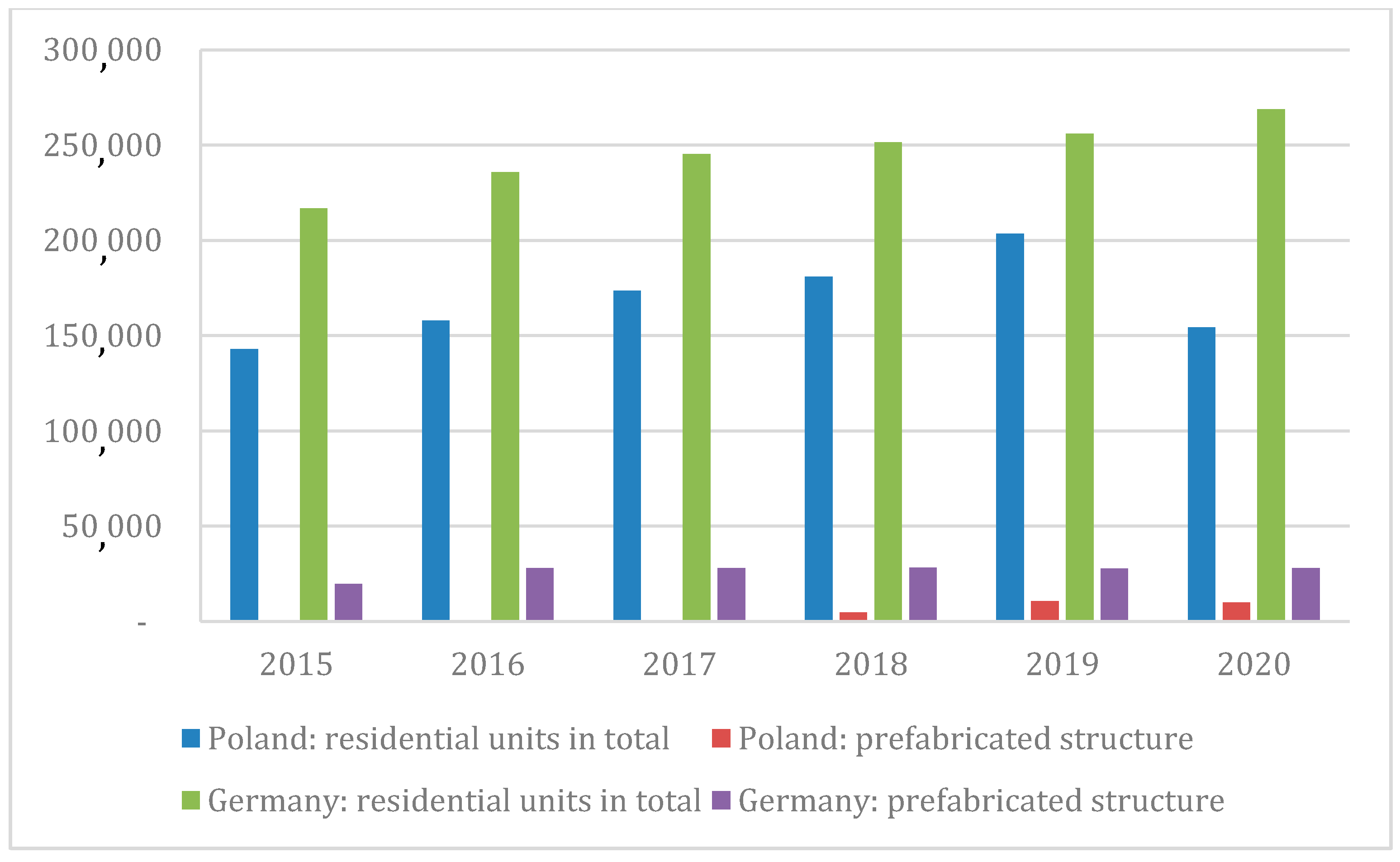
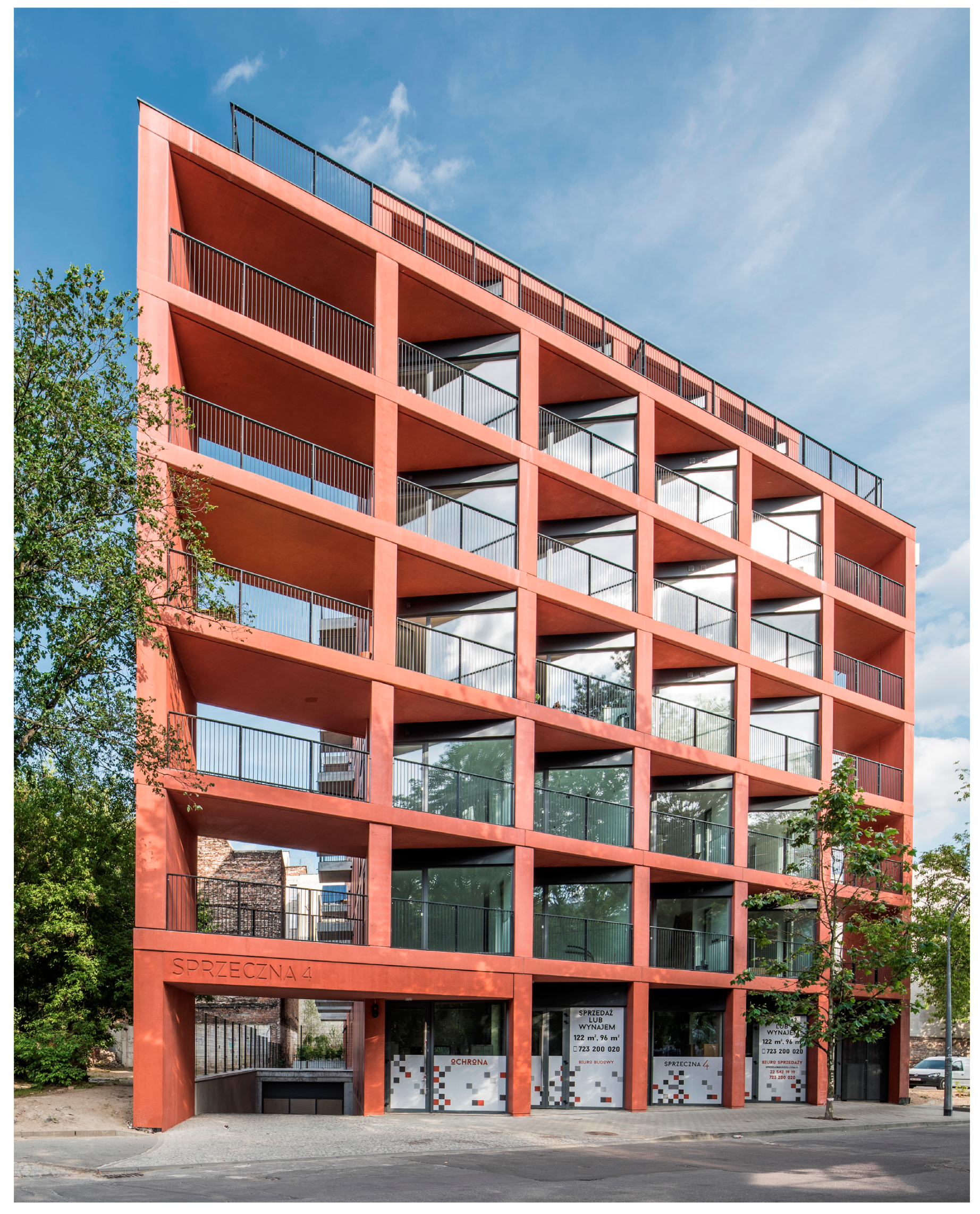

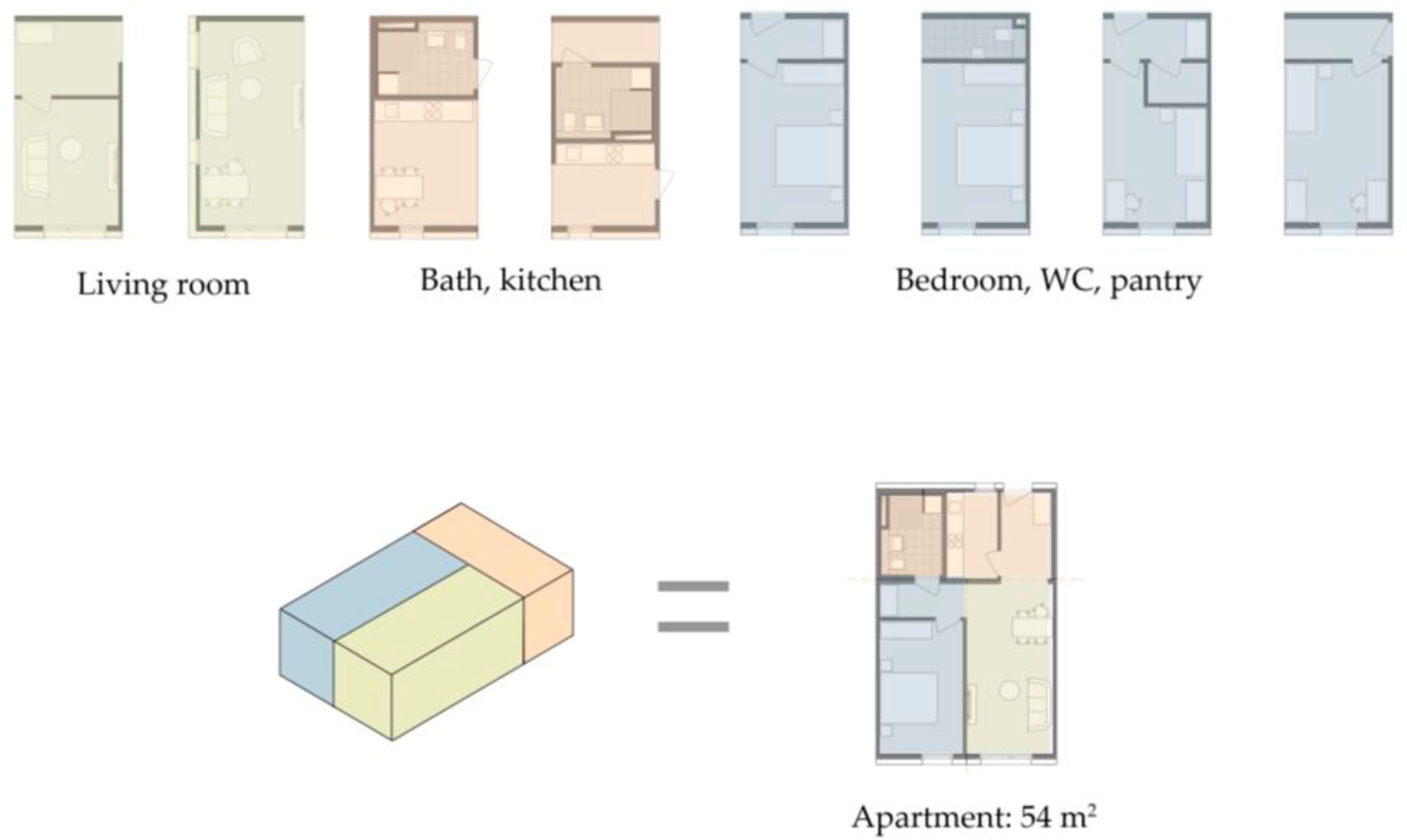

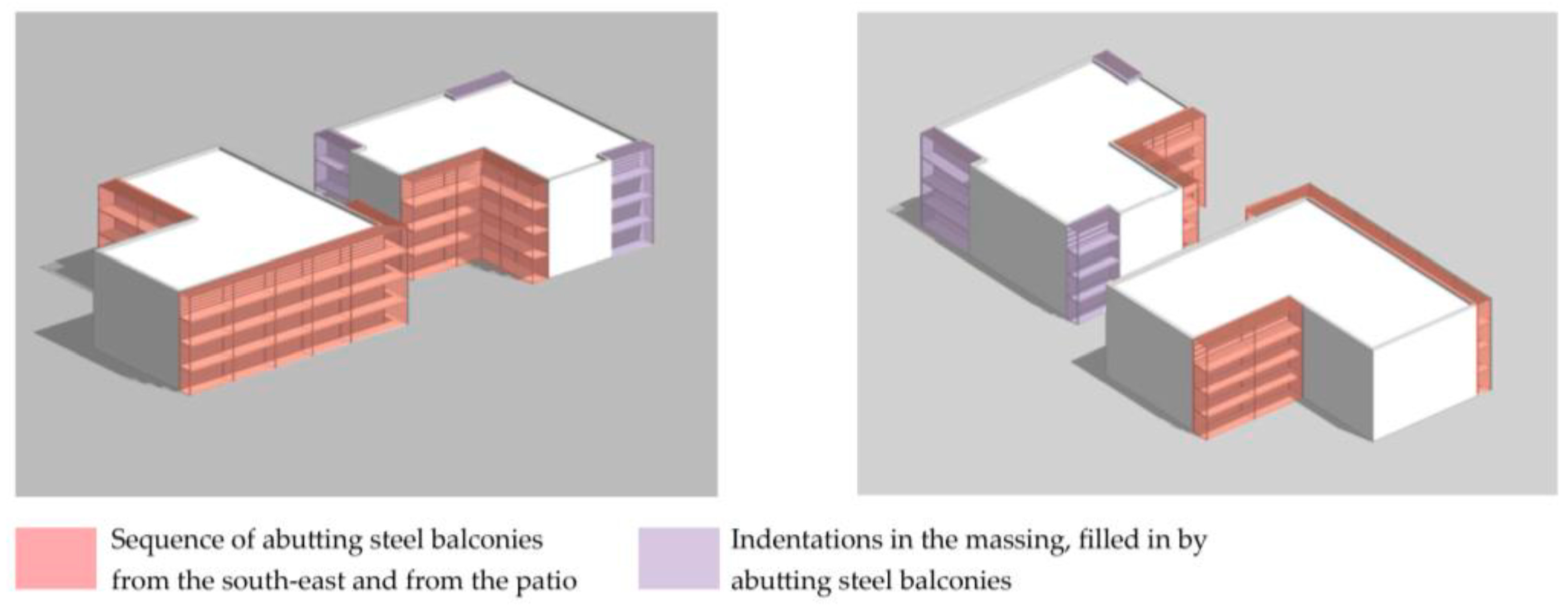
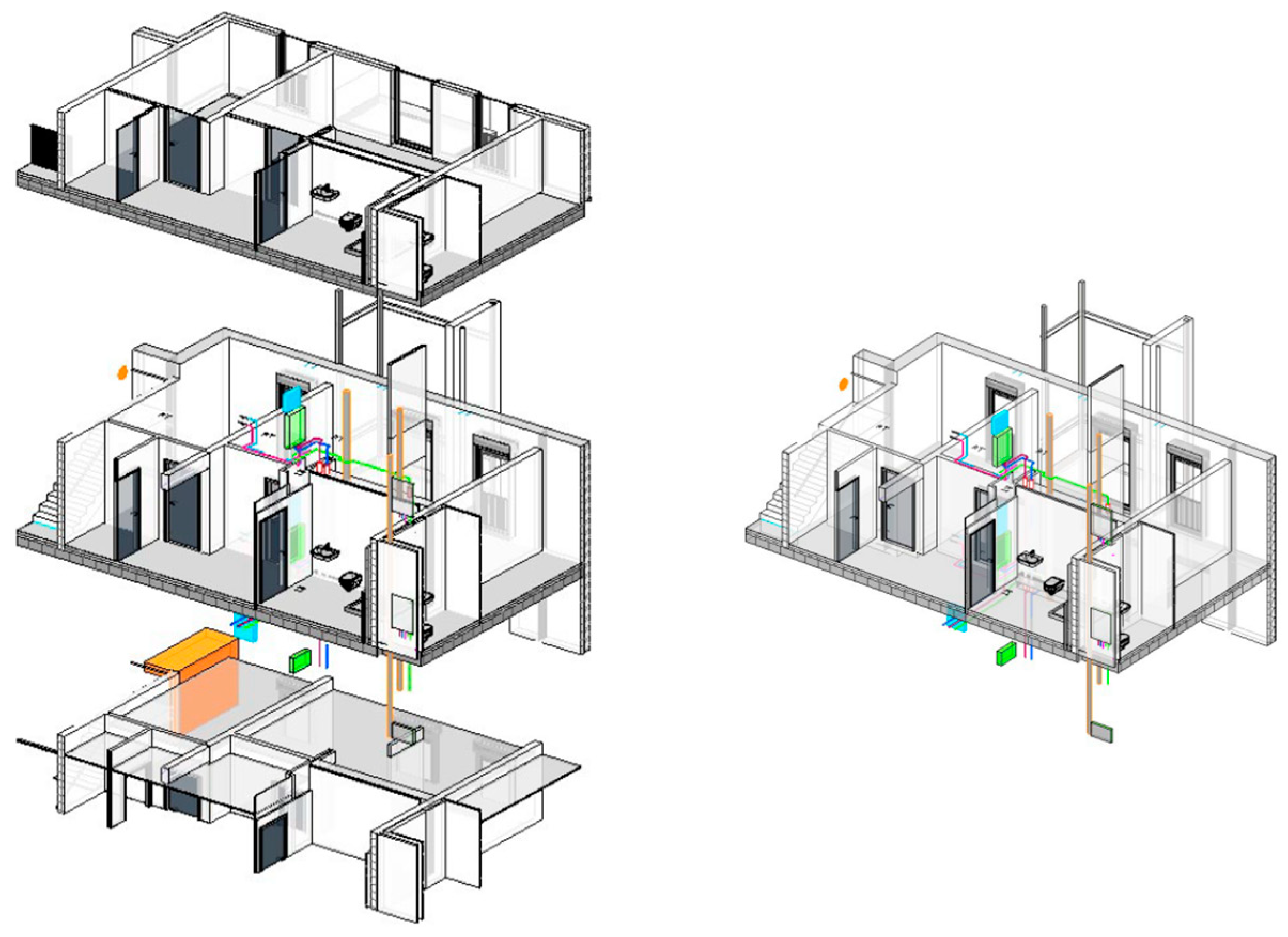
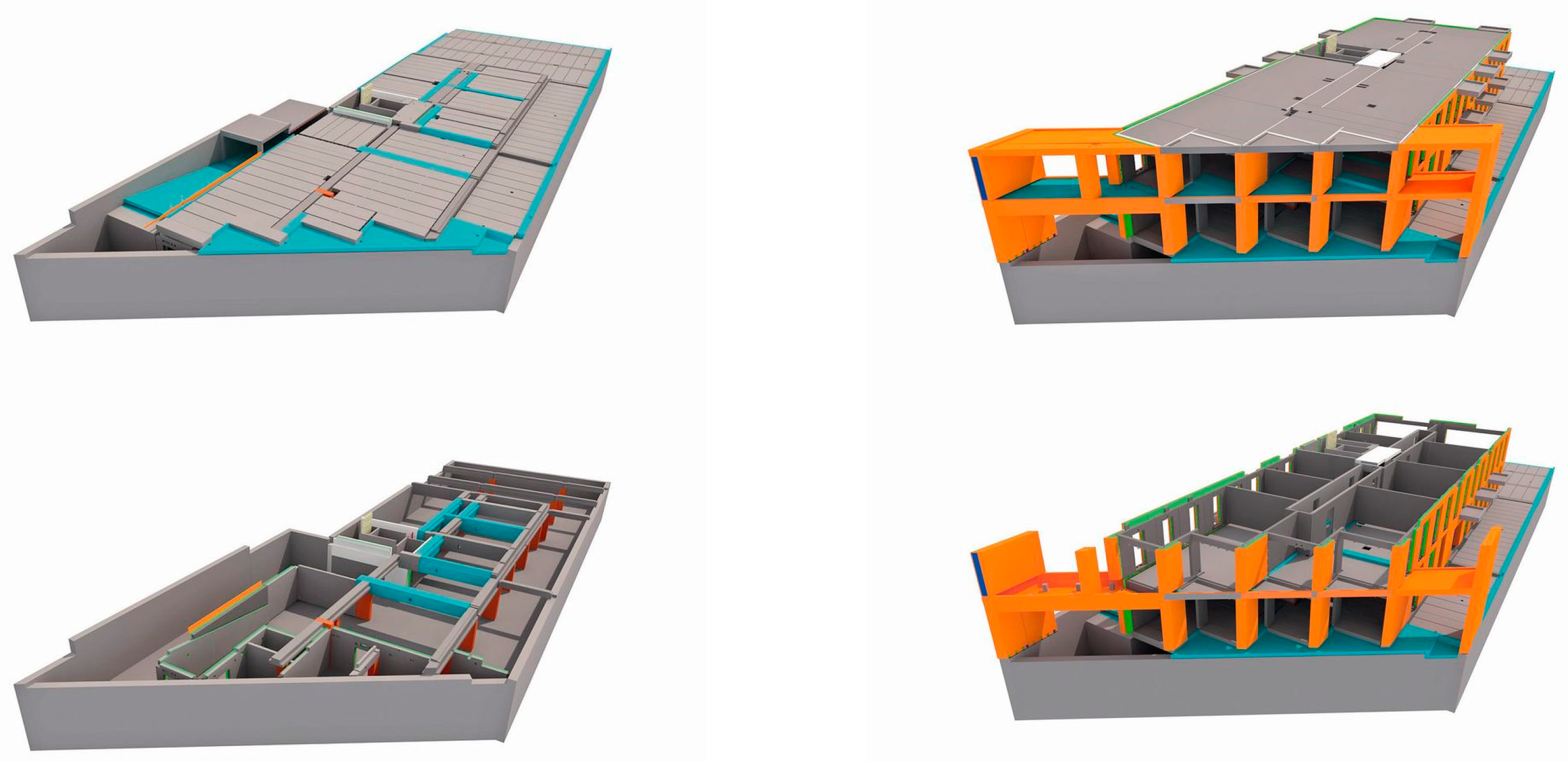
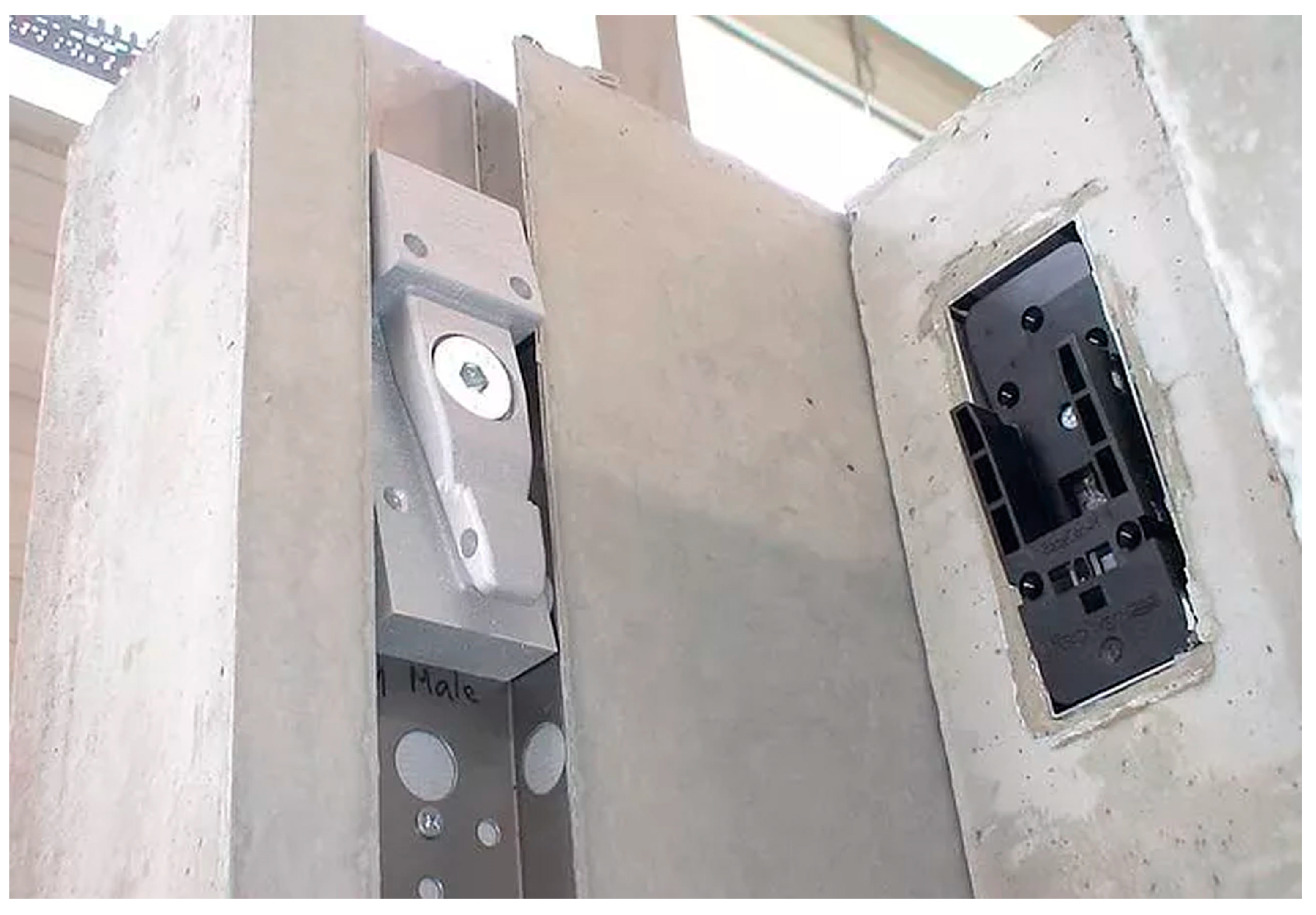
| Poland | 2015 | 2016 | 2017 | 2018 | 2019 | 2020 |
|---|---|---|---|---|---|---|
| Residential units in total | 143,014 | 157,977 | 173,489 | 180,897 | 203,458 | 154,297 |
| Large panel Large block | 181 | 247 | 481 | 4677 | 10,791 | 10,045 |
| Percentage share | 0.1% | 0.2% | 0.3% | 2.6% | 5.3% | 6.5% |
| Germany | 2015 | 2016 | 2017 | 2018 | 2019 | 2020 |
|---|---|---|---|---|---|---|
| Residential units in total | 216,727 | 235,658 | 245,304 | 251,338 | 255,925 | 268,774 |
| Large panel Large block | 19,720 | 27,985 | 27,970 | 28,140 | 27,812 | 28,101 |
| Percentage share | 9.1% | 11.9% | 11.4% | 11.2% | 10.9% | 10.5% |
Publisher’s Note: MDPI stays neutral with regard to jurisdictional claims in published maps and institutional affiliations. |
© 2021 by the authors. Licensee MDPI, Basel, Switzerland. This article is an open access article distributed under the terms and conditions of the Creative Commons Attribution (CC BY) license (https://creativecommons.org/licenses/by/4.0/).
Share and Cite
Kirschke, P.; Sietko, D. The Function and Potential of Innovative Reinforced Concrete Prefabrication Technologies in Achieving Residential Construction Goals in Germany and Poland. Buildings 2021, 11, 533. https://doi.org/10.3390/buildings11110533
Kirschke P, Sietko D. The Function and Potential of Innovative Reinforced Concrete Prefabrication Technologies in Achieving Residential Construction Goals in Germany and Poland. Buildings. 2021; 11(11):533. https://doi.org/10.3390/buildings11110533
Chicago/Turabian StyleKirschke, Paweł, and Dagmara Sietko. 2021. "The Function and Potential of Innovative Reinforced Concrete Prefabrication Technologies in Achieving Residential Construction Goals in Germany and Poland" Buildings 11, no. 11: 533. https://doi.org/10.3390/buildings11110533
APA StyleKirschke, P., & Sietko, D. (2021). The Function and Potential of Innovative Reinforced Concrete Prefabrication Technologies in Achieving Residential Construction Goals in Germany and Poland. Buildings, 11(11), 533. https://doi.org/10.3390/buildings11110533






